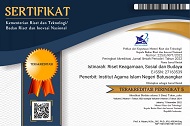Fake Social Mobility: Sebuah Tindakan Kriminal atau Sekedar Pemaksaan Gaya Hidup Hedonisme? (Tinjauan dari Perspektif Masyarakat Bandung Raya)
Abstract
Fake social mobility is a phenomenon where individuals carry out fake social movements/social mobility. This is assessed from several indicators, including the existence of pretense in changing their lifestyle, coercion due to a hedonic lifestyle, and economic conditions that are the opposite of lifestyle. But it should be highlighted, this social change occurred without an increase in income, so that the change in style occurred due to the social environment, for example, actors borrow, beg, force or even steal to support their lifestyle. The method used in this study is the mox method, which combines quantitative and qualitative research methods. The results of the study show that fake social mobility is considered to have the potential to lead to criminal acts, or even depending on the level of influence, fake social mobility itself can be considered a criminal act. However, not all fake social mobility actions are negative phenomena considering one thing or another based on reasons that can be rationalized. As the name implies, fake social mobility cannot be said to be a part of social mobility because it is fake or does not match the real situation.
Keywords
Full Text:
PDF (Bahasa Indonesia)References
Google. (n.d.). Misteri Azura Luna, Sosialita penipu Ri diundang Keluarga Presiden as. Google. Retrieved March 24, 2023, from https://www.google.com/amp/s/inet.detik.com/cyberlife/d-6274717/misteri-azura-luna-sosialita-penipu-ri-diundang-keluarga-presiden-as/amp
Hardianto, F. N. (2009). Analisis Faktor-Faktor Yang Mempengaruhi Tingkat Kriminalitas Di Indonesia Dari Pendekatan Ekonomi. Bina Ekonomi, 13(2).
Ismail, M. (2020). Hedonisme dan Pola Hidup Islam. Jurnal Ilmiah Islamic Resources, 16(2), 193-204.
Mulyadi, S., Basuki, A. H., & Prabowo, H. (2019). Metode penelitian kualitatif dan mixed method: perspektif yang terbaru untuk ilmu-ilmu sosial, kemanusiaan, dan budaya.
Nugrahani, F., & Hum, M. (2014). Metode penelitian kualitatif. Solo: Cakra Books, 1(1), 3-4.
Septiana, A. J. (2020). Gaya hidup hedonisme wanita dewasa awal yang menjadi sugar baby. Psikoborneo: Jurnal Ilmiah Psikologi, 8(3), 551-561.
Setiadi, E. M., & Kolip, U. (2011). Pengantar Sosiologi: Pemahaman Fakta Dan Gejala Permasalahan Sosial: Teori, Aplikasi Dan Pemecahannya. Kencana.
Setianingsih, E. S. (2019). Wabah gaya hidup hedonisme mengancam moral anak. Malih Peddas (Majalah Ilmiah Pendidikan Dasar), 8(2), 130.
DOI: http://dx.doi.org/10.31958/istinarah.v5i1.9034
Refbacks
- There are currently no refbacks.
Copyright (c) 2023 dinda rizky Az - Zahra

This work is licensed under a Creative Commons Attribution-NonCommercial 4.0 International License.
Istinarah: Riset Keagamaan, Sosial dan Budaya
Indexed By:
Istinarah: Riset Keagamaan, Sosial dan Budaya distribute under Lisensi Creative Commons Atribusi-NonKomersial 4.0 Internasional










_.png)









